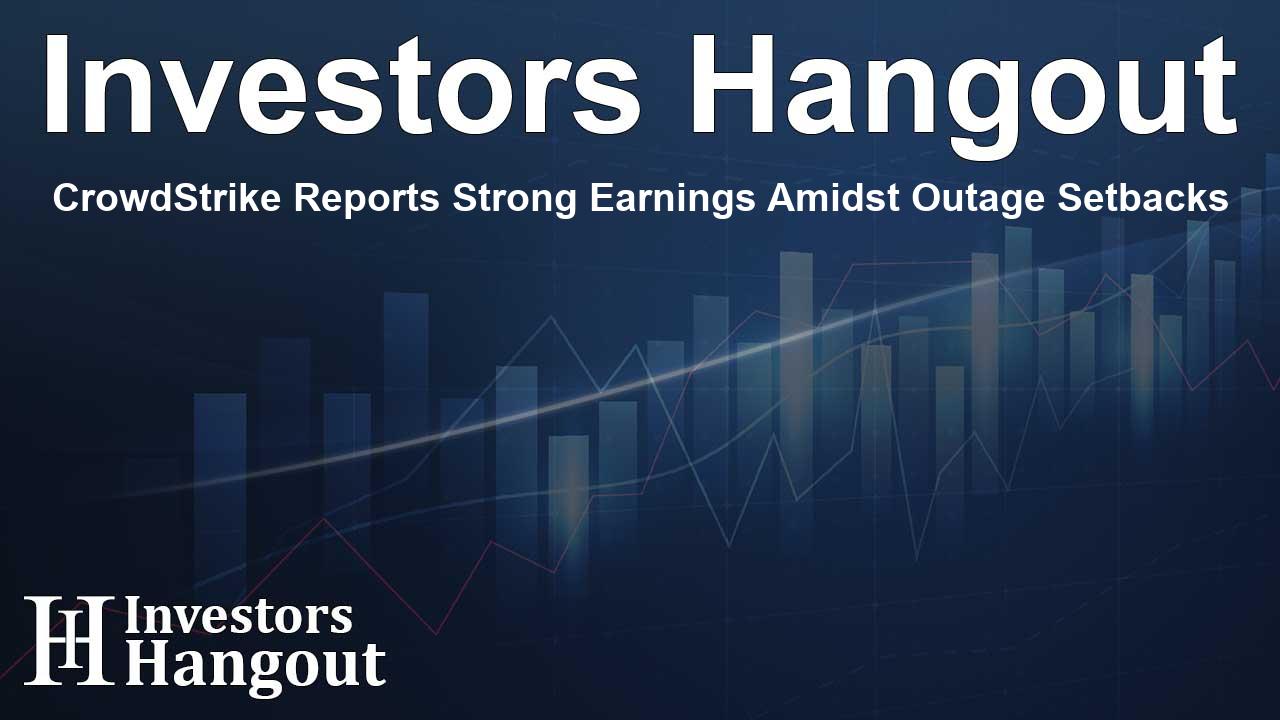CrowdStrike Reports Strong Earnings Amidst Outage Setbacks

Overview of CrowdStrike's Earnings Report
Recently, CrowdStrike (NASDAQ: CRWD) drew significant interest from investors when it released its fiscal second-quarter results. This announcement was particularly important as stakeholders were keen to understand the impact of a widely publicized outage that occurred during the summer.
While CrowdStrike's stock has faced a considerable decline, dropping more than 25% since early July, it has impressively doubled in value over the past year. This stark contrast reflects the market's volatile reaction to the company's challenges and successes.
In this article, we will explore CrowdStrike's latest financial performance and assess whether the company has moved past its recent difficulties.
Financial Performance and Updated Guidance
Despite the outage's timing affecting the second quarter, it did not have a substantial negative impact on CrowdStrike's financial results. The company reported an impressive 32% growth in revenue, reaching $963.9 million, which exceeded earlier forecasts that estimated revenue between $958.3 million and $961.2 million. Additionally, subscription revenue, a vital part of CrowdStrike's business model, grew by 33%, totaling $918.3 million.
CrowdStrike's annual recurring revenue (ARR), which reflects the annualized value of its customer subscription contracts, also increased by 32% to $3.86 billion. The company added $217.6 million in net new ARR during the quarter, showcasing strong customer acquisition and retention.
On the profitability front, CrowdStrike's adjusted earnings per share (EPS) rose significantly from $0.74 a year ago to $1.04 in the latest quarter, surpassing previous guidance that estimated adjusted EPS between $0.98 and $0.99. The operating cash flow was an impressive $326.6 million, while free cash flow stood at $272.2 million. By the end of the quarter, CrowdStrike had approximately $3 billion in net cash and short-term investments, reflecting a solid balance sheet.
Notable growth was seen in key business segments, including cloud security, which surged over 80% to an ARR exceeding $515 million, and Identity Security, which increased by more than 70% to over $350 million. Furthermore, LogScale, the company's Next-Gen SIEM product, experienced remarkable growth, with an ARR increase of over 140%, surpassing $220 million.
Moreover, CrowdStrike noted that over 65% of its customers utilize five or more product modules, with 29% adopting seven or more. The number of deals involving eight or more modules grew by 48%, indicating strong cross-selling potential within its customer base.
Looking ahead, CrowdStrike has projected third-quarter revenue to be between $979.2 million and $984.7 million, with adjusted EPS expected to be between $0.80 and $0.81. However, due to the operational challenges stemming from the outage, management has revised its fiscal year guidance downward, as reflected in the detailed financial metrics provided.
Challenges and Market Insights
CrowdStrike acknowledged that the recent outage led to delayed deals, particularly as a significant portion of sales typically occurs in the final weeks of a quarter. Nevertheless, the company emphasized that most of these opportunities remain in its sales pipeline. Following the outage, CrowdStrike secured two major contracts and has visibility on over $60 million in pending deals anticipated to close in the coming quarters.
The management expects that the aftermath of the outage may result in longer sales cycles and increased scrutiny of deals. As a response, the company aims to encourage clients to commit to the Falcon platform for extended periods, which may lead to a temporary slowdown in upselling initiatives and a potential rise in churn rates. CrowdStrike estimates that these factors could affect ARR and subscription revenue by around $60 million. In light of these challenges, the company plans to shift some sales and marketing investments towards research and development, quality assurance, and customer support to enhance service delivery.
The overall sentiment indicates that these challenges are likely to persist for about a year, necessitating careful management by CrowdStrike's leadership.
Assessing Investment Opportunities
Before the outage, many industry experts viewed CrowdStrike as a leading player in the cybersecurity sector; however, recent disruptions have prompted a reassessment of its overall reputation. Potential customers are now more cautious in their decision-making when considering CrowdStrike's services, while existing clients are taking a more deliberate approach to expanding their service usage.
Despite the challenges following the outage, CrowdStrike's long-term outlook remains intact. If no further incidents occur, the lingering effects are expected to fade over time. However, the company currently trades at a premium, with an estimated price-to-sales ratio of about 14, which requires careful consideration from investors.
While CrowdStrike's valuation has seen significant reductions in recent months, the stock is still not regarded as inexpensive. As it stands, potential investors should evaluate the stock's valuation in relation to its long-term growth potential, which appears balanced at this time.
Conclusion: A Moment for Reflection
For those who often feel they've missed out on investing in successful companies, now may be an important time to closely monitor developments at CrowdStrike.
Investors should stay alert to the evolving situation surrounding CrowdStrike in the wake of the outage and consider the broader implications for their portfolios. This analysis highlights the importance of strategic insights and timing when exploring opportunities in a dynamic market.
Frequently Asked Questions
What were CrowdStrike's recent revenue figures?
CrowdStrike reported revenue of $963.9 million for the second quarter, reflecting a 32% increase year-over-year.
How has the outage affected CrowdStrike's reputation?
The outage has led to increased scrutiny from potential customers and has caused some delays in deal closures.
What is CrowdStrike's outlook for the upcoming quarter?
For the third quarter, CrowdStrike projects revenue between $979.2 million and $984.7 million, with adjusted EPS between $0.80 and $0.81.
What potential impacts does the company foresee due to the outage?
CrowdStrike anticipates slower sales cycles and potential impacts of around $60 million on ARR and subscription revenue.
Is CrowdStrike considered a good investment currently?
While valuation has decreased, investors are encouraged to evaluate the stock's price-to-sales ratio against its long-term prospects before deciding.
About The Author
Contact Riley Hayes privately here. Or send an email with ATTN: Riley Hayes as the subject to contact@investorshangout.com.
About Investors Hangout
Investors Hangout is a leading online stock forum for financial discussion and learning, offering a wide range of free tools and resources. It draws in traders of all levels, who exchange market knowledge, investigate trading tactics, and keep an eye on industry developments in real time. Featuring financial articles, stock message boards, quotes, charts, company profiles, and live news updates. Through cooperative learning and a wealth of informational resources, it helps users from novices creating their first portfolios to experts honing their techniques. Join Investors Hangout today: https://investorshangout.com/
The content of this article is based on factual, publicly available information and does not represent legal, financial, or investment advice. Investors Hangout does not offer financial advice, and the author is not a licensed financial advisor. Consult a qualified advisor before making any financial or investment decisions based on this article. This article should not be considered advice to purchase, sell, or hold any securities or other investments. If any of the material provided here is inaccurate, please contact us for corrections.
